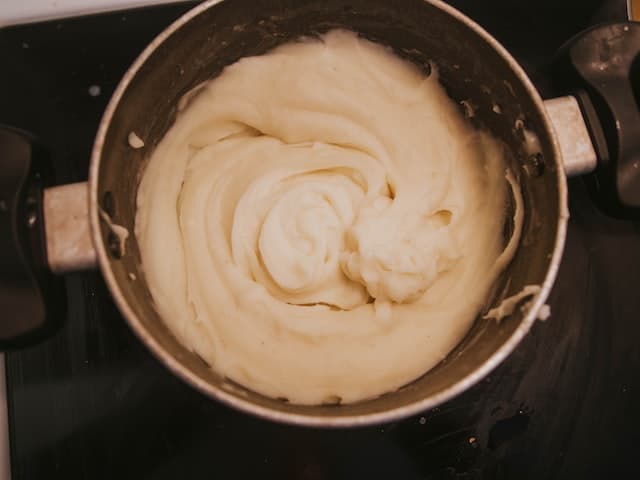Nowadays that almost anything can be stuffed into a mason jar, lidded and processed to become canned, it makes sense to ask the question of whether mashed potatoes can be canned in order to further extend their shelf life.
Mashed potatoes by the way are potatoes that have been turned into a mash using a hand mixer or whisk, and then have milk and seasoning incorporated into the mash at the most basic state.
The very fact that mashed potatoes are mashed, and therefore appear in a mashed form is the reason why they cannot be canned.
This article outlines the reasons why mashed potatoes cannot be canned, and what you can do instead to accelerate the process of making your mashed potatoes.

It presents a health risk
Primarily, there are three reasons why food cannot be canned.
The first is that the food itself prevents the destruction of microorganisms which in turn cause them to breed and cause spoilage or illness when consumed. The second is that the food would prevent the even distribution of heat which will grant grace for the survival of some bacteria. And the last is that the flavor of the food would be greatly affected when it is stuffed into a can, which makes it a terrible idea.
Can you take a guess as to which of the above reasons is why a mashed potato cannot be canned? The second? You’re right. Mashed potatoes cannot be canned because their mashed state prevents proper heat transfer which means some bacteria can thrive and begin to cause the food to spoil or become dangerous when ingested.
In case you didn’t know, the primary reason why food items are canned is to further extend their shelf life. And how is this achieved through canning? It is through the destruction of microorganisms that are on the jar and inside the food using heat and pressure.
Failure to destroy these microorganisms means that they’ll be able to survive and cause food to spoil, and that is exactly what will happen when you try to can mashed potatoes.
Potatoes themselves can be canned
No, it’s not all doom and gloom with potatoes, as they themselves can be sealed in jars and processed.
In fact, if you want to make that quick mashed potatoes using fresh ingredients, one of the best techniques you can use is to can your potatoes, so that you have them ready to mash, cutting out the time needed to peel and boil them.
Using this technique will produce mashed potatoes that are not only delicious, but far superior to frozen mashed potatoes.
How to can potatoes so you make mashed potatoes with them.
Now that we know that canning potatoes is a sure thing, how then do we go about the process.
Before you ever think of canning potatoes for mashing, you first have to bear at the back of your mind these three things.
The first is that you will not be able to can potatoes with their peel on. You have to remove the peels to make sure that you’re reducing the bacterial load that is going into the can which increases the chances of destroying most of the bacteria during processing.
The second is that you have to make sure you’re using potatoes that are meant for mashing such as russets and yukon gold. You’ll definitely find guides elsewhere that recommend you opt for potatoes with low starch content as they won’t break or fall apart after during canning, but it doesn’t really matter in this case as the main goal is mashing anyways, so break or not, so long as they’ll provide the fluffiness, creaminess and the smoothness of mashed potatoes, they’re good to go into the canning jar.
If you have all these at the back of your mind, then we can proceed with the canning process.
Note that we are not providing a specific recipe below, and that we are only providing guidelines and best practices that should be followed for any successful potato canning venture.
Make sure to always follow a tested recipe like the one from USDA, and use this guide in combination to achieve a brilliant end result.
The steps for canning potatoes
Step one:
Wash the potatoes thoroughly under running water using a vegetable brush. The potatoes must be washed in order to remove as much bacterial load as possible so that you don’t end up transferring bacteria to the flesh which dramatically increases the load of bacteria going into the jar, and therefore the risks of spoilage and illness.
Step two:
Peel the potato using a potato peeler or a knife.
Step three:
Cut large potatoes into halves, leave small potatoes between the length of 2 to 3 cm whole. You can also decide to cut the potatoes into cubes but make sure they are all uniform.
Step four:
Blanch the potatoes by cooking them in boiling water for about 2 minutes if they are in cubes and all the cubes are uniform, and for 10 minutes if you have whole potatoes or halves from large potatoes. Now you may be wondering why blanching is necessary and the reason why is because it aids in the deactivation of spoilage causing enzymes and bacteria in and on the potato respectively.
Without deactivation of the enzymes, the potatoes would darken during storage and could potentially lose flavor.
Step five:
Now after blanching, drain the water and pack the potatoes inside a pinch or quart sized jar making sure to leave 1 inch head space. Then, bring another water to a boil and pour it over the potatoes until everything is fully submerged, making sure to maintain the headspace from before which will give room for the expansion of the potatoes during pressure canning as well as aid in achieving a proper seal.
Now there are some recipes that would recommend you use the water you boiled the potatoes in, and while that might save you time, the water does contain a lot of starch which can affect how your potatoes end up looking during storage, your ability to detect spoilage should incase it happens during storage, and also the processing time due to the new added density of the water.
Remember, processing time is quite sensitive when it comes to canning. You have to make sure you get it right so all bacteria are destroyed and the food is safe during storage.
Now some people may recommend that you add salt to the potatoes so that it helps to battle the internal blandness of the potatoes, but this is totally optional.
Step six:
Use a wooden spatula to release air bubbles inside the container, and when you’re done with that adjust the lids and process in a pressure canner.

